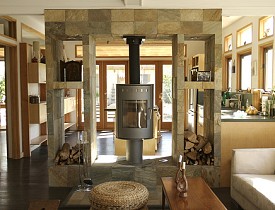Remodeling: Modern vs. Traditional Trim
 Whether you're building a new home or remodeling an older home, choosing the appropriate style of molding and trim can be a daunting task. The array of styles may be overwhelming, but deciding between them is easier if you consider a few basic rules of thumb.
Whether you're building a new home or remodeling an older home, choosing the appropriate style of molding and trim can be a daunting task. The array of styles may be overwhelming, but deciding between them is easier if you consider a few basic rules of thumb.
Consider the style of your home, NOT the style of your furniture.
A Victorian home would look out of place decorated with trim reminiscent of an Arts & Crafts home, or visa-versa. Before you step out to shop for new molding, determine the style of your home -- Contemporary, Colonial, Victorian, Craftsman, etc. Next, go to a bookstore and look at decorating books and trade magazines with pictures of homes similar to your own. This will give you a starting point for choosing molding and trim styles that will enhance, not clash, with interior space. Let furniture define your personal taste and personality, not the style of architectural detail in your home! Mismatched molding and trim can actually depress market value and reduce your home's appeal upon future resale. Details make all the difference.
Consider your budget.
Don't overdo by purchasing expensive moldings or installing architectural detail where it isn't needed. Older traditional homes typically have more architectural details, including crown molding in rooms with high ceilings, while modern contemporary homes require a minimalist approach with clean simple lines. If your budget is limited, tackle "dressing" rooms with basics first, adding more elaborate details later as your pocketbook allows. Begin with the most lived-in rooms, leaving places like the laundry room or playroom for later. Don't rush to get it finished, especially if it means sacrificing quality materials or compromising what you really love for something less appealing. Crown moldings, wainscoting and chair rails can easily be installed at a later date, while baseboards, door and window trim are essential basics.
After you've picked a style, explore the price of materials through several suppliers. Costs of molding vary greatly, from less than $1 per linear foot to over $3 per linear foot, and even more for customized milling to match existing trim found in significantly older or historic homes. Molding and trim is also manufactured out of various materials -- plastic, PVC, softwood (like pine), hardwoods (like cherry, oak and maple), and price reflects quality. Fees for installation may also be based upon style -- plain molding is much easier to install than a crown molding with dentil accent. Some general contractors don't install complicated moldings, leaving design work to contractors specializing in finish work. Make sure you talk with your contractor before making a final choice so you'll know how your preferred style will effect the overall cost of your project.
The rules of breaking the rules:
Occasionally, it's okay to break the rules and choose moldings either more modern or traditional than the style of a home. For example, modern homes have a baseboard height of 4", while historic or traditional homes have baseboards 6" or greater. If you have a modern home and like the look of a larger baseboard, consider installing a simple baseboard, without elaborate detailing, to a height of 5 to 6 inches. If you have an older traditional home but don't like all the fancy door and window trim, consider less detail but stay with wider trim boards, which accommodate a simpler style but still keep with the age of home. Generally, don't go to extremes.
Test molding samples first.
Not sure how molding styles will look in your home? Purchase sample pieces and and tape them up to see how they'll look. As long as the style is consistent throughout, architectural molding will enhance the overall appearance of your home.
Looking for a Pro? Call us (866) 441-6648

Remodeling Average Costs
Remodeling Contractors Experiences

My Son’s Stamped Concrete Patio Was A Fast Track, Quality Job

Professional Stain Adds The Finishing Touch To My New Cedar Deck



